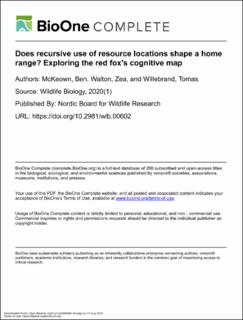Does recursive use of resource locations shape a home range? Exploring the red fox's cognitive map.
Peer reviewed, Journal article
Published version
Permanent lenke
https://hdl.handle.net/11250/2677593Utgivelsesdato
2020Metadata
Vis full innførselSamlinger
Originalversjon
https://doi.org/10.2981/wlb.00602Sammendrag
A home range represents the outcome of the interplay between an environment, an animal’s understanding of that envi-ronment, and its subsequent movement decisions. Yet, recent studies suggest that recursive movement strategies have been overlooked in the shaping of animal home range patterns. Using fourteen GPS collared red foxes, we investigated within home range movements for recursive movement behaviour, suggesting a cognitive map, and explored how these shape ani-mal space-use patterns. We found that red foxes showed significant clustering in recorded positions, indicative of recursive site use. An average of 43% of positions were found in defined clusters that covered a proportional area of only 1% of their recorded range. Ground-truthing revealed that clusters were attributed to recursive visits, and extended residence time at clumped food sources, bed or den sites, routes and vantage points in the landscape. Our results provide evidence that, while red foxes maintained exploratory movement, recursive site use played a significant role in optimising movements between distinct core areas. We conclude that these patterns support the concept of cognitive mapping enabling recursive resource use, which can lead to emergence of bounded space use, rather than a continuous drifting across the landscape. We propose that by identifying resource locations that are used recursively; it is possible to move a step closer in revealing an animal’s cognitive map, or indeed, the movement behaviour underlying home range formation.

